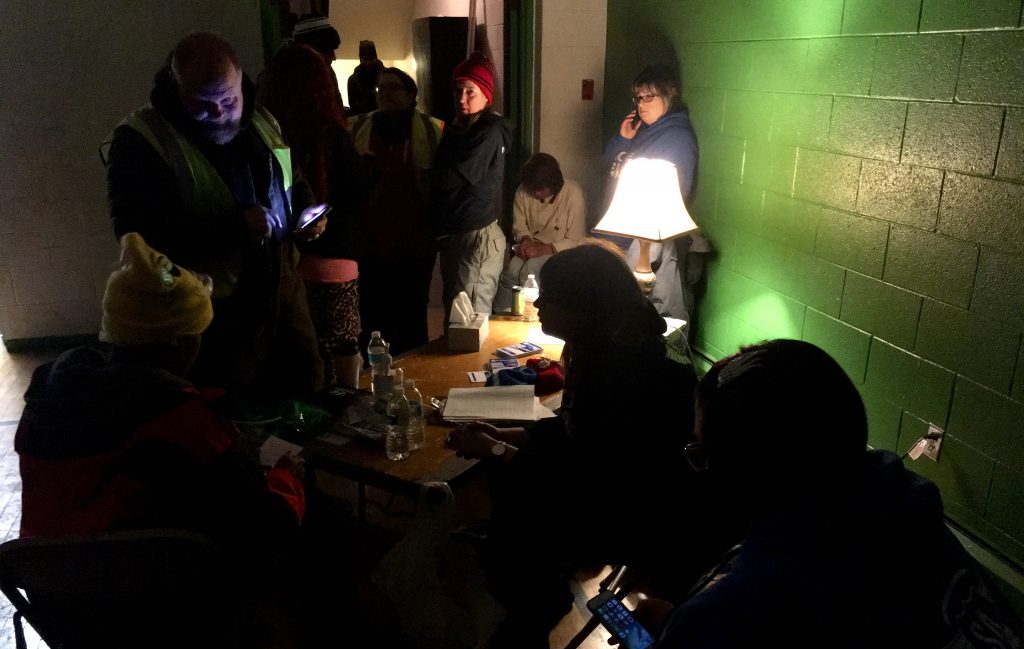Homeless Providers Brace For The Worst
Quarantine requirements, more living on streets, complicate the problem.

With the pandemic in full force and evictions rising, homeless care providers are preparing for the worst. Volunteers at the Street Angels Milwaukee Outreach emergency shelter at Ascension Lutheran Church speak with a guest in 2018. File photo by Elliot Hughes/NNS.
Despite efforts by shelters, the city and the county, Shelly Sarasin fears the worst is yet to come for Milwaukee’s homeless population.
Sarasin is the co-executive director of Street Angels, a nonprofit that helps feed, shelter and advocate for those facing homelessness. She said she’s noticed an increase in those living outside in comparison with earlier years, though definitive numbers are hard to come by.
From having to require a 72-hour quarantine, where people have to isolate within a shelter, to ensuring people are social distancing, Milwaukee’s homeless shelters face serious challenges from the coronavirus.
During the beginning of the pandemic, many shelters suspended in-person services for residential and outpatient programs and limited the number of people shelters could house, effectively reducing their capacity.
A rise in homelessness?
Now, shelters are seeing “an uptick in individuals living outside,” said Ashley Wisnefske, housing and outreach manager at Outreach Community Health Centers. “Some shelters aren’t taking new people, and even for those that are, the influx is much slower as people have to quarantine before being allowed into a center.”
Outreach Community Health Centers provides primary care, behavioral health care and community services like rapid rehousing for families facing homelessness.
Early this year, places like Clare Hall, on the grounds of the St. Francis de Sales Seminary, opened to provide temporary shelter for people, as did many motels, to flatten the increase of people living on the street.
“We don’t necessarily have more people facing homelessness,” she said. “There has just been a decrease in space to shelter those who were already facing homelessness.”
Other shelter leaders echo Esteves’ observations.
“We had about a 30 to 40 percent drop in residents,” said Aurelia Brown, director of Joy House at Milwaukee Rescue Mission. “Because we have a decent sized space, we are still able to serve about 60 percent of the people we usually do.”
According to 2020 Point-in-Time Count, there were 970 people without homes as of January. Once the pandemic hit in March and local shelters cut back to 50 percent to 60 percent of their capacities, city and county officials came together to provide temporary housing for about 177 people, according to data provided by the Institute for Community Alliances. This number does not include those housed at Clare Hall.
A Point-In-Time, or PIT, count is a statistically reliable, unduplicated count of people experiencing homelessness during a designated one-night period. Wisconsin conducts this count twice per year.
Is it better or worse?
Sarasin said a decrease in those sleeping outside does not necessarily mean a decrease in people without homes.
“Around this time last year, we were passing out about 180 meals” per day, Sarasin said on Aug. 12. “We are planning to pass out about130 to140 tomorrow.”
She said that winter is always hard for those living on the streets, but with the ongoing pandemic and evictions on the rise, this year could be worse than usual.
As leaders prepare for the expected next wave of COVID-19, homeless care providers are focused on ensuring their clients aren’t left behind.
“We don’t want to open another opportunity for COVID-19 to hurt this population, and people will not just be left in the wind when the pandemic is over,” Sarasin said.
Where you can find help
Resources for those who experience homelessness in Milwaukee (and how you can help)
This story was originally published by Milwaukee Neighborhood News Service, where you can find other stories reporting on fifteen city neighborhoods in Milwaukee.
More about the Coronavirus Pandemic
- Governors Tony Evers, JB Pritzker, Tim Walz, and Gretchen Whitmer Issue a Joint Statement Concerning Reports that Donald Trump Gave Russian Dictator Putin American COVID-19 Supplies - Gov. Tony Evers - Oct 11th, 2024
- MHD Release: Milwaukee Health Department Launches COVID-19 Wastewater Testing Dashboard - City of Milwaukee Health Department - Jan 23rd, 2024
- Milwaukee County Announces New Policies Related to COVID-19 Pandemic - County Executive David Crowley - May 9th, 2023
- DHS Details End of Emergency COVID-19 Response - Wisconsin Department of Health Services - Apr 26th, 2023
- Milwaukee Health Department Announces Upcoming Changes to COVID-19 Services - City of Milwaukee Health Department - Mar 17th, 2023
- Fitzgerald Applauds Passage of COVID-19 Origin Act - U.S. Rep. Scott Fitzgerald - Mar 10th, 2023
- DHS Expands Free COVID-19 Testing Program - Wisconsin Department of Health Services - Feb 10th, 2023
- MKE County: COVID-19 Hospitalizations Rising - Graham Kilmer - Jan 16th, 2023
- Not Enough Getting Bivalent Booster Shots, State Health Officials Warn - Gaby Vinick - Dec 26th, 2022
- Nearly All Wisconsinites Age 6 Months and Older Now Eligible for Updated COVID-19 Vaccine - Wisconsin Department of Health Services - Dec 15th, 2022
Read more about Coronavirus Pandemic here





















